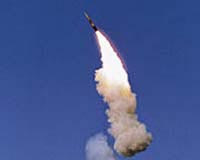Russia's Missile Bulava Attempt Fails
Russia admitted on Thursday another failed test of its much-touted Bulava intercontinental missile, after unusual lights were spotted in Norway across the border from the launch site.

The submarine-based Bulava (Mace) missile has been billed as Russia's newest technological breakthrough to support its nuclear deterrent, but the repeated test failures are an embarrassment for the Kremlin.
The missile failed in its 13th test on Wednesday morning, Russia's leading economic dailies reported on Thursday, quoting sources in the military-industrial complex.
Hours later, the Defense Ministry admitted the failure, saying the launch had been made by the Dmitry Donskoi nuclear submarine from a submerged position in the White Sea.
"It has been established ... that the missile's first two stages worked as normal, but there was a technical malfunction at the next, third, stage of the trajectory," a Defense Ministry spokesman said.
Norwegian experts reported sighting of phenomena in the atmosphere near the White Sea, where earlier Bulava rockets were fired, the Kommersant and Vedomosti newspapers reported.
Russia's REN-TV showed footage of a spiral of white light, which it said was taken on Wednesday in Norway. The footage also showed a bright white light with a long blue tail on the horizon.
The Kremlin has touted the missile as a unique weapon capable of breaching any air defense and a way to bolster the country's once mighty submarine fleet.
Analysts criticize Moscow's hurry to build the Bulava, as it already has a highly reliable Soviet-built Sineva submarine-based ballistic missile.
They also question awarding the Bulava contract to the Moscow Institute of Thermal Technology which has never before built missiles for submarines.
The New York Times has contributed to the report.
Subscribe to Pravda.Ru Telegram channel, Facebook, RSS!




